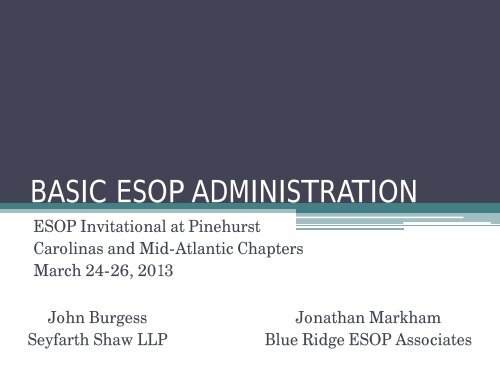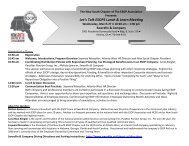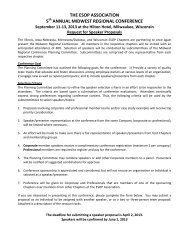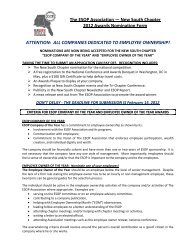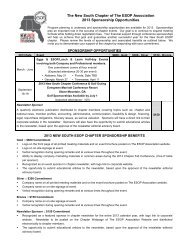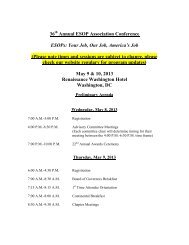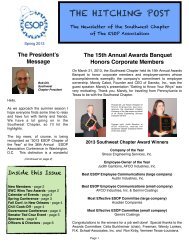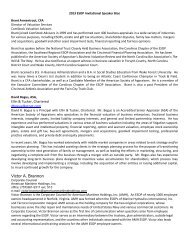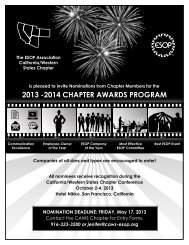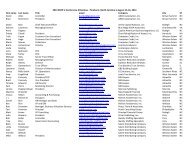BASIC ESOP ADMINISTRATION - The ESOP Association
BASIC ESOP ADMINISTRATION - The ESOP Association
BASIC ESOP ADMINISTRATION - The ESOP Association
- No tags were found...
Create successful ePaper yourself
Turn your PDF publications into a flip-book with our unique Google optimized e-Paper software.
<strong>BASIC</strong> <strong>ESOP</strong> <strong>ADMINISTRATION</strong><strong>ESOP</strong> Invitational at PinehurstCarolinas and Mid-Atlantic ChaptersMarch 24-26, 2013John BurgessSeyfarth Shaw LLPJonathan MarkhamBlue Ridge <strong>ESOP</strong> Associates
John Burgess - Seyfarth Shaw LLPJonathan Markham – Blue Ridge <strong>ESOP</strong> AssociatesOverview• What is an <strong>ESOP</strong>?• Data Gathering• Plan Eligibility• Allocations• Compliance Testing• Distributions and Diversifications• Government Filings• Participant Reporting
John Burgess - Seyfarth Shaw LLPJonathan Markham – Blue Ridge <strong>ESOP</strong> AssociatesWhat is an <strong>ESOP</strong>?• An <strong>ESOP</strong> is a tax-qualified, defined contributionemployee benefit plan.• <strong>ESOP</strong>s are required to invest primarily in employersecurities.• <strong>ESOP</strong>s are unique in the fact that they can borrowmoney in order to purchase employer securities• <strong>ESOP</strong>s are governed by the Internal Revenue Codeand are subject to Employee Retirement IncomeSecurity Act (ERISA) of 1974.• <strong>ESOP</strong>s are required to have a written plandocument.
John Burgess - Seyfarth Shaw LLPJonathan Markham – Blue Ridge <strong>ESOP</strong> AssociatesPlan Document• Plan Document▫ Amendments• Trust Document• Leverage <strong>ESOP</strong> Documents▫ Stock Purchase Agreement▫ Stock Pledge Agreement▫ Loan Agreement▫ Promissory Note
John Burgess - Seyfarth Shaw LLPJonathan Markham – Blue Ridge <strong>ESOP</strong> AssociatesPlanning Your Annual Allocation• Create a timeline• Know your deadlines• Know the parties involved▫ ERISA Council▫ Appraiser▫ Third-Party Administrator▫ Auditor
John Burgess - Seyfarth Shaw LLPJonathan Markham – Blue Ridge <strong>ESOP</strong> AssociatesData Gathering – Census• Information is needed on all employees who worked for the companyduring the plan year.▫▫▫▫▫▫▫▫▫▫▫▫▫▫▫▫▫Social Security NumberNameDate of BirthDate of HireDate of TerminationStatus – Active, Terminated, Terminated due to death or disabilityRehire InformationHours WorkedGross CompensationPlan Defined CompensationEmployee 401(k) DeferralsEmployer 401(k) Match or Other ContributionsEmployee Classification – Leased, Union, etc.List of Corporate OfficersShares Held Outside of the <strong>ESOP</strong>Certain Family Relationship InformationSynthetic Equity Held
John Burgess - Seyfarth Shaw LLPJonathan Markham – Blue Ridge <strong>ESOP</strong> AssociatesParticipation• Eligible employees become participants in theplan after completion of the plan's eligibilityrequirements.• Maximum Plan Entry Provisions:▫ Age 21▫ One Year of Service• Year of Service is defined as 1,000 hours in a 12-month period, regardless of employment• Two Years of Service can be required if theparticipants are fully vested immediately.
John Burgess - Seyfarth Shaw LLPJonathan Markham – Blue Ridge <strong>ESOP</strong> AssociatesParticipation – Entry Dates• Once satisfying the plan’s eligible an employeewill enter the plan the plan’s pre-defined entrydate.• Maximum entry date is the earlier of:▫ First day of the plan year which begins after thedate the employee completes the eligibilityrequirements.▫ Six months following the date the employeecompletes the eligibility requirements.
John Burgess - Seyfarth Shaw LLPJonathan Markham – Blue Ridge <strong>ESOP</strong> AssociatesRehires• If a participant had a vested benefit in the plan before they terminated theywill enter the plan on the date they are rehired.• If a participant did not have a vested benefit in the plan before theyterminated then the rule of parity is used to decided if their prior servicecounts for eligibility purposes.▫Rule of Parity – credit for prior years of service is excluded if the consecutivebreaks in service are greater than:• Five or• <strong>The</strong> aggregate number of pre-break years of service• If an employee terminates employment and is rehired before they incur abreak in service then their prior service is counted for eligibility purposes.• If an employee terminates employment and is rehired after they incur abreak in service then their prior service is not counted for eligibilitypurposes.• Break in service is generally defined as a year with 500 or less hours.
John Burgess - Seyfarth Shaw LLPJonathan Markham – Blue Ridge <strong>ESOP</strong> AssociatesVesting• A participant’s non-forfeitable account balance.• Maximum Vesting Schedules (post PPA)Years ofService6 YearGraded3 YearCliff1 Year 0% 0%2 Years 20% 0%3 Years 40% 100%4 Years 60% 100%5 Years 80% 100%6 Years 100% 100%
John Burgess - Seyfarth Shaw LLPJonathan Markham – Blue Ridge <strong>ESOP</strong> AssociatesVesting• Year of Service – generally 1,000 hours in a planyear.▫ <strong>The</strong> hour requirement can be less than 1,000▫ Years of Service can be based off of elapsed time▫ Years of Service prior to the effective date of theplan can be excluded or partially counted▫ Years of Service prior to age 18 can be excluded
John Burgess - Seyfarth Shaw LLPJonathan Markham – Blue Ridge <strong>ESOP</strong> AssociatesVesting Exceptions• Certain types of contribution are always 100% vested:▫ Employee elective deferrals▫ Rollover contributions▫ Designated Roth contributions▫ After-tax employee contributions• A participant must be 100% once they reach NormalRetirement Age (NRA)▫ Maximum NRA is the later of age 65 and 5 years ofparticipation in the plan• Generally plans will fully vest the accounts ofparticipants who terminate due to death or disabilityalthough it is not required.
John Burgess - Seyfarth Shaw LLPJonathan Markham – Blue Ridge <strong>ESOP</strong> AssociatesGathering Trust Information• <strong>ESOP</strong> bank account information– bankstatements and/or check register• Contribution amounts, including accruals• Dividend amounts, including accruals• Loan payments• Distribution and Diversification information• Information regarding new stock transactions
John Burgess - Seyfarth Shaw LLPJonathan Markham – Blue Ridge <strong>ESOP</strong> AssociatesShare Release• Principal Only MethodCurrent Principal PaymentsCurrent and Future Principal Paymentsx Shares in Suspense• Principal and Interest MethodCurrent Principal and Interest PaymentsCurrent and Future Principal and Interest Paymentsx Shares in Suspense
John Burgess - Seyfarth Shaw LLPJonathan Markham – Blue Ridge <strong>ESOP</strong> AssociatesAllocation – Contributions• Participants may be eligible to receive a portion of theyear’s contributions in any plan year in which they metcertain requirements.▫ Generally a participant will be eligible for a contribution ifthey:• Work 1,000 hours in the plan year and are actively employed atthe end of the plan year.• Plans cannot require more than 1,000 hours.• Terminate employment due to retirement, death, or disability• Plan are not required to provide these exceptions.• Employer Contributions are typically allocated in a proratamanner to all eligible participants based on theireligible compensation or points.
John Burgess - Seyfarth Shaw LLPJonathan Markham – Blue Ridge <strong>ESOP</strong> AssociatesAllocation - Forfeitures• <strong>The</strong> non-vested portion of a participant’s account balance istypically forfeited upon the earlier of a 5 consecutive year break inservice or a complete distribution of the participant’s vested accountbalance.▫ Deemed Distribution – participants who are zero percent vested aregenerally deemed to receive a distribution as of the date they terminate.• Rehire Reinstatements▫ If a participant is rehired before a 5 consecutive year break in service andthey pay back their distribution, their forfeited account balance shouldbe reinstated.▫ Reinstatements typically come from current year forfeitures but can alsocome from Employer Contributions or investment earnings.• Reallocated forfeitures are typically allocated on the same basis asEmployer Contributions.
John Burgess - Seyfarth Shaw LLPJonathan Markham – Blue Ridge <strong>ESOP</strong> AssociatesAllocation – Dividends• Allocated Stock▫ Generally allocated to participants based on theamount of shares they hold.• Unallocated Stock▫ Generally allocated to participants based on theireligible compensation or points.▫ Can also be allocated to participants based ontheir total beginning account balance, includingother investments.• Dividends can be passed through to participants
John Burgess - Seyfarth Shaw LLPJonathan Markham – Blue Ridge <strong>ESOP</strong> AssociatesAllocation – Investment Earnings• Typically allocated to each participant based ontheir other investment account.• Can be allocated to each participant based ontheir beginning account balance, includingemployer securities• Withdrawals and Forfeitures are often excludedfrom this basis.
John Burgess - Seyfarth Shaw LLPJonathan Markham – Blue Ridge <strong>ESOP</strong> AssociatesAllocation• Other allocations to consider:▫ Stock Repurchase▫ Stock Purchase▫ Rebalancing/Reshuffling
John Burgess - Seyfarth Shaw LLPJonathan Markham – Blue Ridge <strong>ESOP</strong> AssociatesHighly Compensated Employee (HCE)Determination – 414(q)• 5% Owner – Any employee who owns more than 5%of the Employer, regardless of compensation, duringthe current or preceding plan year. Certain familyattribution rules apply.• Top Paid – Employees who receive compensationfrom the Employer in excess of $115,000 (adjustedfor cost of living)▫ Top Paid Group – <strong>The</strong> number of HCEs can be limitedto the top 20% of all employees in the company.• This election must be used by all of the Employer’s plansand must be written into the plan document.
John Burgess - Seyfarth Shaw LLPJonathan Markham – Blue Ridge <strong>ESOP</strong> AssociatesKey Employee Determination –416(i)(11)• 5% Owner – Any employee who owns more than 5% ofthe Employer, regardless of compensation. Certainfamily attribution rules apply.• 1% Owner – Any employee who owns more than 1% ofthe Employer and whose annual compensation exceeds$150,000• Officer – Any employee who is an officer and whoseannual compensation exceeds $165,000 (adjusted forcost of living)▫ <strong>The</strong> number of officers is limitedNumber ofEmployeesMaximumNumber ofOfficers30 or less 331-500 10%501 or more 50
John Burgess - Seyfarth Shaw LLPJonathan Markham – Blue Ridge <strong>ESOP</strong> AssociatesNondiscrimination Test – 401(a)(4)• Ensures that benefits do not discriminate in thefavor of HCEs.▫ Safe Harbor – If contributions and reallocatedforfeitures are allocated pro-rata to compensationand the compensation definition is consideredsafe-harbor under 414(s) then no testing isrequired▫ Non-Safe Harbor – if the plan uses compensationthat is not a designed safe-harbor or if the planuses a points method of allocation then the planmust be tested using the general test.
John Burgess - Seyfarth Shaw LLPJonathan Markham – Blue Ridge <strong>ESOP</strong> AssociatesMaximum Deductible ContributionLimit - 404• Under Section 404(a)(3) the total amount ofdeductible contributions to all qualified planscannot exceed 25% of covered compensation.▫ Individual compensation is limited to $255,000 in2013▫ Compensation is not limited by ‘mid-year’compensation election• Under Section 404(a)(9) leveraged C-Corporations do not have to apply interestpayments on exempt loans to the contributionlimit.
John Burgess - Seyfarth Shaw LLPJonathan Markham – Blue Ridge <strong>ESOP</strong> AssociatesMinimum Coverage – 410(b)(1)• Ratio Test – <strong>The</strong> percentage of covered NHCEs mustbe at least 70% of the percentage of HCEs who arecovered.▫ Example• Average Benefits TestTotal NHCE HCETotal Employees 157 152 5Excludable Employees 32 32 0Non-Excludable Employees 125 120 5Benefiting Employees 117 112 5Ratio Percentage 93.33%
John Burgess - Seyfarth Shaw LLPJonathan Markham – Blue Ridge <strong>ESOP</strong> AssociatesMaximum Annual Additions – 415(c)• Limits the annual additions of each participant• <strong>The</strong> maximum annual addition is the lesser of:▫▫100% of compensation, or$51,000 (for plan years ending in 2013, adjusted for cost of living)• Annual Additions▫▫▫Employee 401(k) deferralsEmployer contributions• If the plan is leveraged, the lesser of fair market value of shares released or theamount of payments may be used.Reallocated forfeitures• One-Third Test – Reallocated forfeitures of employer securities acquiredwith the proceeds of an exempt loan and employer contributions applied tointerest payments on an exempt loan shall not be applied to the 415 limit ifthe plan passes the one-third test▫▫No More than one-third of the employer contributions applied to principal andinterest payments on an exempt loan are allocated to HCEs<strong>The</strong> employer is a C-Corporation
John Burgess - Seyfarth Shaw LLPJonathan Markham – Blue Ridge <strong>ESOP</strong> AssociatesTop Heavy Test - 416• A company’s defined contribution plans will be considered topheavy if, as of the determination date, the aggregate of the accountsof key employees under the plans exceeds 60% of the aggregate ofthe account balances of all employees under such plans.▫ Certain balances are excluded• Former key employees• Participants who terminated in a prior year• Unrelated rollovers▫ Certain distributions are added back:• Distribution that occurred during the 1-year period ending on thedetermination date• In-Service distributions which occurred during the 5-year period endingon the determination date• If the plans are considered top heavy there is a required minimumcontribution of the lesser of 3% or the highest contribution rate ofthe key employees.
John Burgess - Seyfarth Shaw LLPJonathan Markham – Blue Ridge <strong>ESOP</strong> AssociatesProhibited Allocation Rule – 1042 –409(n)• If company stock is sold to the <strong>ESOP</strong> by ashareholder who elected Section 1042 taxtreatment certain participants cannot receive anallocation of assets attributable to those shares▫ During the non-allocation period the sellingshareholder and certain family members cannotreceive an allocation of assets attributable to 1042shares▫ Shareholders holding more than 25% of companystock and certain family members cannot receivean allocation of assets attributable to 1042 shares.
John Burgess - Seyfarth Shaw LLPJonathan Markham – Blue Ridge <strong>ESOP</strong> AssociatesProhibited Allocation in S-Corporations– 409(p)• Ensures that if an <strong>ESOP</strong> holds shares of company stockin an S-Corporation that no assets attributable to thecompany stock are allocated to disqualified person in anon-allocation year.• Non-Allocation Year is a year in which disqualifiedperson own at least 50% of the company stock.• Disqualified Persons▫ 10% Individual Rule – any person who is deemed to own10% or more of company stock▫ 20% Family Rule – any person who, along with certainfamily members, is deemed to own 20% or more ofcompany stock• Synthetic Equity• 24/7 test
John Burgess - Seyfarth Shaw LLPJonathan Markham – Blue Ridge <strong>ESOP</strong> AssociatesDiversification – 401(a)(28)• Age 55 and 10 year of participation• 6 Election Periods▫▫Periods 1-5 – 25% of eligible stockPeriods 6 – 50% of eligible stock• Eligible to diversify a ‘cumulative’ percentage of stock• Applies only to post 1986 stock• Diversification is satisfied through:▫▫▫Distribution directly to the participantTransfer to another qualified plan (401(k)) that has at least three investmentoptionsKeeping the assets in the <strong>ESOP</strong> but offering at least three investment options forthe participants.• Due Date:▫▫Notice must be provided within 90 days after the close of the plan year• Preliminary NoticeAssets must be diversified no later than 180 days after the close of the plan year.
John Burgess - Seyfarth Shaw LLPJonathan Markham – Blue Ridge <strong>ESOP</strong> AssociatesDistributions• Distribution Policy• Types of Distributions▫ Due to Termination▫ Required Minimum Distributions (age 70½)▫ In-Service Distributions▫ Hardship Withdrawals▫ Participant Loans
John Burgess - Seyfarth Shaw LLPJonathan Markham – Blue Ridge <strong>ESOP</strong> AssociatesDistributions• Distribution Timing▫ Death, Disability, or Normal Retirement – generallythe plan year following termination▫ Termination for other reason – may be delayed untilfive years following the year of termination• Forms of Distributions▫ Cash▫ Stock• Types of Distributions▫ Lump Sum▫ Installments
John Burgess - Seyfarth Shaw LLPJonathan Markham – Blue Ridge <strong>ESOP</strong> AssociatesDistributions• Required to give participants at least 30 days toelect a distribution• Special tax notice• Required Federal and State tax withholding• Distributions without consent▫ Less than $1,000 in cash▫ $1,000 to $5,000 transfer to an IRA
John Burgess - Seyfarth Shaw LLPJonathan Markham – Blue Ridge <strong>ESOP</strong> AssociatesForm 5500 – Annual Return/Report ofEmployee Benefit Plan• Information Return that must be filed electronically.• Large vs. Small Plans – 80-120 Participant Rule• Due Date:▫ <strong>The</strong> end of the 7 th month following the last day of theplan year▫ Form 5558 – Extension of Time• Gives an additional 2 ½ months• Must be filed before the original Form 5500 due date• Open to public inspections▫ www.efast.dol.gov
John Burgess - Seyfarth Shaw LLPJonathan Markham – Blue Ridge <strong>ESOP</strong> AssociatesForm 8955-SSA• Annual registration statement identifyingseparate participants with deferred vestedbenefits• Used to report terminated participants who havenot been paid their vested balance.• Not open to public inspection• Due Date:▫ Same as the Form 5500 including applicable Form5558 extension
John Burgess - Seyfarth Shaw LLPJonathan Markham – Blue Ridge <strong>ESOP</strong> AssociatesForm 1099• Form 1099-R▫ Records distributions and diversifications paid toparticipants during the year▫ Records 404(k) pass through dividends from the <strong>ESOP</strong>paid directly to participants• Form 1099-DIV▫ Records pass through dividends that are not runthrough the plan• Due Date:▫ To participants by January 31 st▫ To the IRS by February 28 th or March 31 st if filedelectronically
John Burgess - Seyfarth Shaw LLPJonathan Markham – Blue Ridge <strong>ESOP</strong> AssociatesForm 945• Used to report federal income tax withheldduring the year.• Deposit Schedules▫ Monthly▫ Semi-Weekly▫ Under $2,500• Due Date:▫ January 31 st• Different states have different withholding andreporting requirements
John Burgess - Seyfarth Shaw LLPJonathan Markham – Blue Ridge <strong>ESOP</strong> AssociatesParticipant Statements• All participants and beneficiaries must be given astatement at least annual or, if the plan has self-directaccounts, quarterly.• Needs to include:▫ Account balance▫ Vested portion▫ Value of each investment as of the most recent valuation▫ Additional details required on quarterly statements.• Due Date:▫ Annual - on or before the date the Form 5500, includingextension, is filed.▫ Quarterly – at least 45 days after the end of each quarter
John Burgess - Seyfarth Shaw LLPJonathan Markham – Blue Ridge <strong>ESOP</strong> AssociatesSummary Plan Description (SPD)• Provides the provisions of the plan document inlayman’s terms.• Due Date:▫ For new <strong>ESOP</strong>s – 120 days after the plan is adopted or120 days after the plan is effective, whichever is later▫ For new participants – 90 days after becoming aparticipation▫ For beneficiaries – 90 days after first receivingbenefits.• Summary Material Modification (SMM) –amendment to the SPD
John Burgess - Seyfarth Shaw LLPJonathan Markham – Blue Ridge <strong>ESOP</strong> AssociatesSummary Annual Report (SAR)• Provides a summary of the Form 5500 to planparticipants and beneficiaries.• Due Date:▫ 9 months after the plan year end or▫ 2 months after the due date of the Form 5500,including extension, if later
QuestionsJohn BurgessAssociateSeyfarth Shaw LLPWashington, D.C.JBurgess@Seyfarth.comJonathan MarkhamPlan AdministratorBlue Ridge <strong>ESOP</strong> AssociatesCharlottesville, VAJMarkham@BlueRidge<strong>ESOP</strong>.com


